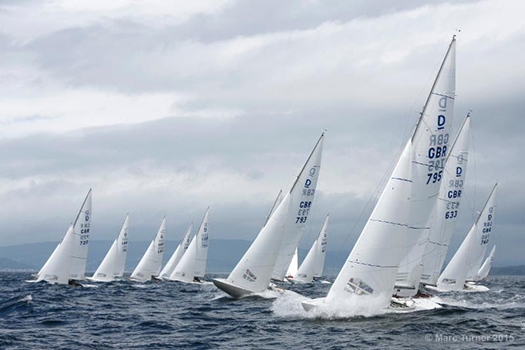#dragon – The opening day of the 2015 Scottish Mortgage Investment Trust Edinburgh Cup in Largs certainly lived up to the Clyde's reputation for being able to deliver almost every weather condition within a matter of moments. The weather gods threw everything from less than three to almost thirty knots at the twenty strong International Dragon fleet in rapid succession and Race Officer Chris Hadden and the Scottish Sailing Institute's Race Committee did an excellent job of keeping up with the conditions to provide two terrific opening races.
By the end of the day it was no surprise to see that experience counts for a lot and in the overall standings Julia Bailey, sailing GBR720 Aimee, and Gavia Wilkinson-Cox, sailing GBR761 Jerboa, lead the regatta on equal points with Aimee just edging ahead on count back thanks to her win in the opening race.
The winner of the second race by a handsome margin was Bocci Aoyama's JAP50 Yeavis, which puts him into third overall, three points behind the ladies and two points ahead of Martin Payne in GBR789 Bear. In fifth place overall and just a single point behind Bear is Patrick Gifford sailing GBR515 Basilisk, who is also the leading Corinthian (all amateur) boat.
The day had begun with a thirty minute postponement in sub three knots. Finally the breeze filled in a little, but as the Race Committee were in the throws of starting the first race a "White water wall", as Gavia described it, rolled down the Clyde and before long the fleet were in big seas and almost 30 knots of breeze.
The first beat was close to survival conditions and the first run saw some some spectacular surfing, challenging heavy airs gybing and more than a few thrills and spills. The second lap was almost as full on and it wasn't until the third and final beat that conditions abate a little. At the line Aimee led GBR795 Excite, helmed by Tom Vernon, and Jerboa across the line with Bear fourth and Martin Makey sailing GBR704 Ganador fifth.
Race two could not have been more different with the wind down to ten knots at the start and continuing to drop and destabilise as the afternoon wore on. With the left side of the course apparently favoured, there was a lot of traffic at the pin end of the line and several people were over eager.
Sadly Excite failed to return and was disqualified, but amongst those who turned back were Jerboa and Bear who were then forced off to the right. Mike Budd's GBR793 Harry found themselves buried at the pin so also elected to tack and come off the line on port across the fleets transoms.
Yeavis meanwhile had had a clear start but tacked onto port to clear her air. They were about to tack back when crew Kasper Harsberg spotted that first Jerboa, Harry and Bear and then Mike Holmes in GBR760 Handsoff were making significant gains on the right. They made the brave decision to put all their eggs in one basket and bang the right corner. The decision was a race winner and by the first mark they had an enormous lead.
Second to round mark one was Harry with Richard Leask in GBR489 Kestra third, Jerboa fourth and Handsoff fifth. On the run Jerboa pulled up into third hard on the heels of Harry, while further back down the pack both Bear and Aimee were making rapid gains through the fleet. With the wind going right Yeavis defended their lead all the way to the finish.
Jerboa did everything she could to get through Harry and her efforts were finally rewarded in the closing moments when Harry crossed Jerboa on port but then tacked and lost momentum in the by now very light airs, allowing Jerboa to slip through to leeward for a second place. Harry finished third with Aimee snatching fourth from Patrick Gifford's GBR515 Basilisk on the final approach to the line.
With three more days and four further races still to come the regatta is wide open. The forecast promises further very varied conditions and its clear that whoever wins the 2015 Scottish Mortgage Investment Trust Edinburgh Cup and become British Dragon Champion will have had to work very hard to do so. Weather permitting races three and four are scheduled for tomorrow starting at 11.00 and if both races are completed the single discard will come into play.
































































